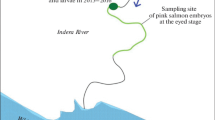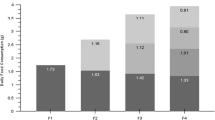Abstract
In addition to the strong influence of the broodstock diet on the development and survival of offspring, domestication may also interfere with the larval life success. We obtained eggs from wild and domesticated Salminus hilarii females and domesticated males. Wild females were caught in the Tiete River and tributaries, and the domesticated females were born three years before the beginning of the experiment in the Ponte Nova Fish Farm. Animals from both groups were fed with the same feed to exclude feed variables. The eggs and larvae were sampled at 0, 8, 16, and 28 h after spawning (HAS), with the last sampling (28 HAS) coinciding with hatching time. After hatching, samplings proceeded at 32, 48, 66, and 96 HAS, with the last sampling (96 HAS) corresponding to the end of yolk sac consumption. Finally, the last experimental period was during the larvae exogenous feeding phase, at 102, 118, 166, and 214 HAS. Our data revealed that domestication of S. hilarii females influenced fatty acid (FA) metabolism during embryo and larva development. However, the structure of membrane phospholipid FA remained mostly stable, with changes principally in the neutral fraction. When the external conditions, mainly water and feed quality, remained constant, domestication of S. hilarii females did not significantly affect the structural FA composition but influenced the selectivity of consumption and/or storage of specific FA.

Similar content being viewed by others
Abbreviations
- CPE:
-
Carp pituitary extract
- EFA:
-
Essential fatty acid
- FR:
-
Fertilization rate
- G1:
-
Group 1—embryos and larvae from wild broodstock
- G2:
-
Group 2—embryos and larvae from domesticated broodstock
- FA:
-
Fatty acid
- EPA:
-
Eicosapentaenoic fatty acid
- DHA:
-
Docosahexaenoic fatty acid
- ARA:
-
Arachidonic acid
- GC:
-
Gas chromatograph
- FAME:
-
Fatty acid methyl esters
- FID:
-
Flame ionization detector
- HAS:
-
Hours after spawning
- SFA:
-
Saturated fatty acid
- MUFA:
-
Monounsaturated fatty acid
- PUFA:
-
Polyunsaturated fatty acid
- HUFA:
-
Highly unsaturated fatty acid
- TG:
-
Triglycerides
- n3:
-
Omega 3 fatty acid
- n6:
-
Omega 6 fatty acid
- n3/n6:
-
Ratio between omega 3 and omega 6 fatty acids
References
Agostinho AA, Gomes LC, Pelicice FM (2007) Ecologia e manejo de recursos pesqueiros em reservatórios do Brasil. EDUEM, Maringá
Araki H, Cooper B, Blouin MS (2007) Genetic effects of captive breeding cause a rapid, cumulative fitness decline in the wild. Science 318:100–103
Bell JG, Farndale BM, Bruce MP, Navas JM, Carillo M (1997) Effects of broodstock dietary lipid on fatty acid compositions of eggs from sea bass Dicentrarchus labrax. Aquaculture 149:107–119
Bromage NR (1996) Broodstock management and seed quality–general considerations. In: Bromage NR, Roberts RJ (eds) Broodstock management and egg and larval quality. Institute of Aquaculture, Blackwell, London, pp 1–24
Christie WW (2003) Lipid analysis: isolation, separation, identification and structural analysis of lipids. The Oily Press, England
Falk-Petersen S, Sargent JR, Fox C, Falk-Petersen IB, Haug T, Kjørsvik E (1989) Lipids in Atlantic halibut (Hippoglossus hippoglossus) eggs from planktonic samples in Northern Norway. Mar Biol 101:553–556
Folch J, Less M, Sloane M, Stanley GH (1957) A simple method for the isolation and purification of total lipids from animal tissues. J Biol Chem 226:497–503
Fraser AJ, Gamble JC, Sargent JR (1988) Changes in lipid content, lipid class composition, and fatty acid composition of developing eggs and unfed larvae of cod (Gadus morhua). Mar Biol 99:307–313
Glencross BD (2009) Exploring the nutritional demand for essential fatty acids by aquaculture species. Aquaculture 1:71–124
Gunasekera RM, De Silva SS, Ingram BA (1999) Early ontogeny-related changes of the fatty acid composition in the Percichthyid fishes trout cod, Maccullochella macquariensis and Murray cod, M. peelii peelii. Aquat Living Resour 12:219–227
Haliloglu HI, Aras NM, Yanik T, Atamanalp M, Kocaman EM (2003) Investigation of changes in fatty acid composition at early development stages of rainbow trout (Oncorhynchus mykiss). Turk J Biol 27:1105–1109
Hamza N, Mhetli M, Khemis IB, Cahu C, Kestemont P (2008) Effect of dietary phospholipid levels on performance, enzyme activities and fatty acid composition of pikeperch (Sander lucioperca) larvae. Aquaculture 275:274–282
Harrel RM, Woods LC (1995) Comparative fatty acid composition of eggs from domesticated and wild striped bass Morone saxatilis. Aquaculture 133:225–233
Hildebrand SG, Bell MC, Richey EP, Anderson JJ (1980) Analysis of environmental tissues related to small-scale hydroelectric development IV: design and consideration for passing fish upstream around dams. Oak Ridge National Laboratory, Environmental Services Division, Virginia
Honji RM, Narcizo AM, Borella MI, Romagosa E, Moreira RG (2009) Patterns of oocyte development in natural habitat and captive Salminus hilarii Valenciennes, 1850 (Teleostei: Characidae). Fish Physiol Biochem 35:109–123
Izquierdo MS, Fernández-Palácios H, Tacon AGJ (2001) Effect of broodstock nutrition on reproductive performance of fish. Aquaculture 197:25–42
Mourente G, Carrascosa MA, Velasco C, Odriozola JM (1989) Effect of gilthead sea bream (Sparus aurata L.) broodstock diets on egg lipid composition and spawning quality. EAS 10:179–180
Palácios E, Racotta IS, Aparicio B, Arjona O, Martínez-Palacios CA (2007) Lipid classes and fatty acids during embryogenesis of captive and wild silverside (Chirostoma estor estor) from Pátzcuaro Lake. Fish Physiol Biochem 33:81–91
Parra G, Rønnestad I, Yúfera M (1999) Energy metabolism in eggs and larvae of the Senegal sole. J Fish Biol 55:205–214
Parrish CC (1999) Determination of total lipid, lipid classes, and fatty acids in aquatic samples. In: Arts MT, Wainman BC (eds) Lipids in freshwater ecosystems. Springer, Berlin, pp 4–20
Rainuzzo JR, Reitan KI, Olsen Y (1997) The significance of lipids at early stages of marine fish: a review. Aquaculture 155:102–115
Sargent JR, Henderson RJ, Tocher DR (1989) The lipids. In: Halver JE (ed) Fish nutrition. Academic Press, California, pp 181–257
Sargent J, McEvoy L, Estevez A, Bell G, Henderson J, Tocher D (1999) Lipid nutrition of marine fish during early development: current status and future directions. Aquaculture 179:217–229
Sargent JR, Bell MV, Henderson RJ, Tocher DJ (2001) The metabolism of phospholipids and polyunsaturated fatty acids in fish. Aquaculture 43:103–124
Silversand C, Norberg B, Haux C (1996) Fatty-acid composition of ovulated eggs from wild and cultured turbot Scophthalmus maximus in relation to yolk and oil globule lipids. Mar Biol 125:269–278
Soivio A, Niemisto M, Backstrom M (1989) Fatty acid composition of Coregonus muksun Pallas: changes during incubation, hatching, feeding and starvation. Aquaculture 79:163–168
Terova G, Saroglia M, Papp ZG, Cecchini S (1998a) Ascorbate dynamics in embryos and larvae of sea bass and sea bream, originating from broodstocks fed supplements of ascorbic acid. Aquacult Int 6:357–367
Terova G, Saroglia M, Papp ZG, Cecchini S (1998b) Dynamics of collagen indicating amino acids, in embryos and larvae of sea bass (Dicentrarchus labrax) and gilthead sea bream (Sparus aurata), originated from broodstock fed with different vitamin C content in the diet. Comp Biochem Phys 121A:111–118
Tocher DR (2010) Fatty acid requirements in ontogeny of marine and freshwater fish. Aquacult Res 41:717–732
Tocher DR, Fraser AJ, Sargent JR, Gamble JC (1985) Fatty acid composition of phospholipids and neutral lipids during embryonic and early larval development in Atlantic herring (Clupea harengus L.). Lipids 20:69–74
Tocher DR, Agaba M, Hastings N, Bell JG, Dick JR, Teale AJ (2002) Nutritional regulation of hepatocyte fatty acid desaturation and polyunsaturated fatty acid composition in zebrafish (Danio rerio) and tilapia (Oreochromis niloticus). Fish Physiol Biochem 24:309–320
Vazzoler AEAM (1981) Manual de métodos para estudos biológicos de populações de peixes; reprodução e crescimento. CNPq, Brasília
Vazzoler AEAM (1996) Biologia da reprodução de peixes teleósteos: teoria e prática. EDUEM, Maringá
Verri T, Terova G, Dabrowsky K, Saroglia M (2011) Peptide transport and animal growth: the fish paradigm. Biol Lett. doi:10.1098/rsbl.2010.1164
Whyte JNC, Clarke WC, Ginther NG, Jensen OT (1993) Biochemical changes during embryogenesis of the Pacific halibut, Hippoglossus stenolepis (Schmidt). Aquacult Fish Manage 24:193–201
Wiegand MD (1996) Utilization of yolk fatty acids by goldfish embryos and larvae. Fish Physiol Biochem 15:21–27
Yang Z (1995) Development of a gas chromatographic method for profiling neutral lipids in marine samples. Dissertation, University of Newfoundland
Zar JH (1999) Bioestatiscal analysis. Prentice-Hall, New Jersey
Zhu P (1998) A study of biochemical composition in captive Atlantic halibut (Hippoglossus hipoglossus) eggs and larvae. Dissertation, University of Newfoundland
Acknowledgments
This work was supported by a research grant from FAPESP (01/10483-1) and a Master’s fellowship from Conselho Nacional de Desenvolvimento Científico e Tecnológico (CNPq). The authors would also like to thank the fishermen who helped us to collect the wild females as well as the DAEE (Departamento de Águas e Energia Elétrica do Governo do Estado de São Paulo) for providing the facilities to perform experiments at the Ponte Nova Hatchery.
Author information
Authors and Affiliations
Corresponding author
Rights and permissions
About this article
Cite this article
Araújo, B.C., Honji, R.M., de Mello, P.H. et al. The influence of captive breeding on the fatty acid profiles of Salminus hilarii (Characiformes: Characidae) eggs and larvae. Aquacult Int 20, 1161–1181 (2012). https://doi.org/10.1007/s10499-011-9472-6
Received:
Accepted:
Published:
Issue Date:
DOI: https://doi.org/10.1007/s10499-011-9472-6




